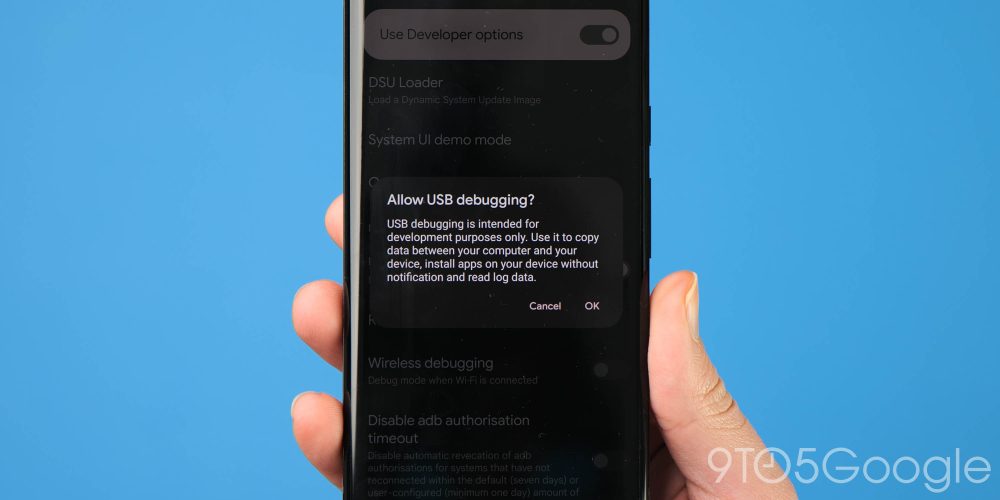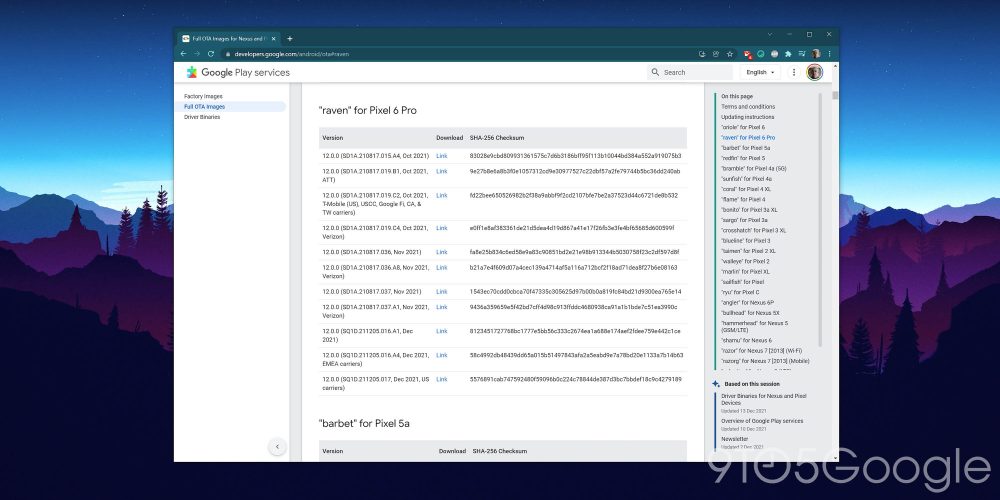
Unfortunately, the December 2021 update for the Pixel 6 and 6 Pro caused some notable issues, but you may have updated before the update was pulled. Because of the signal issues and other problems, you might want to downgrade your Pixel 6 from the December 2021 update to the November 2021 patch – at least until problems are resolved in the coming weeks.
You’re going to need to do a few things before you can revert to a stable previous Android 12 build. Before you even begin, be sure to back up ALL of your data before even attempting this. You WILL lose your device data, as this method requires a FULL device wipe, and it will be wiped several times during this process.
This is just an unfortunate side effect of the downgrade process, but it’s a necessary one. That said, with the December 2021 security patch causing issues with calling and bugs that saw certain features disabled, a downgrade may be necessary for you.
A patch in late January will be released to fix the problems; until then, you might want to just revert to the November 2021 update to ensure you can use your Pixel 6 or 6 Pro as intended. It’s also important to note that this process is perfectly safe, and you will be able to pull future updates or manually sideload with no issues.
Note: This guide is also tailored for Windows users, meaning that the process may vary for those using MacOS or Linux.
- Download and install Android SDK Platform-tools
- Enable USB debugging and OEM unlocking
- Download the most recent compatible Factory Image
- Boot into device bootloader
- Unlock bootloader
- Enter the flash command
- Relock bootloader (optional)
- Reboot your phone
1. Download and install Android SDK Platform-Tools package
You’ll need to use Android Debug Bridge to downgrade your current Android 12 build to an older version. We recommend installing the unzipped platform-tools package on your desktop for quick access when running commands. You can download the latest platform-tools zip file from here.
Alternatively, Nexus Tools from Corbin Davenport offers a very simple way to ensure that you have the very latest version of Platform-Tools on your Windows, Mac, or Linux machine at all times. Nexus Tools has been written in Dart, so it can run on Linux, macOS, Windows, Windows Subsystem for Linux, and Chrome OS. Once Nexus Tools is finished, you can run adb, fastboot, and other commands with zero problems or issues.
2. Enable USB debugging and OEM unlocking

Firstly, ensure that you have Developer Options enabled on your Pixel. You can do that by heading to your device Settings > About phone, now tap “Build number” until a message confirms that you have Developer options enabled.
Now you need to head to Settings > System > Advanced > Developer options (you may need to expand a hidden menu for this). Before we are ready to continue, you will need to scroll down and enable “OEM unlocking,” as this is integral for further steps. Now scroll slightly further down to the “Debugging” section and tap the “Allow USB debugging” option.
3. Download the Factory Image for your device

This is necessary for the Android downgrade process on your Pixel 6 – or any Google Pixel device. You’ll need to download the correct Factory Image for your device. This is essentially just a blank slate for your smartphone or snapshot of that particular Android build at that time. You can grab it from Google’s Factory Image OTA hosting site, which contains all Factory Images for Pixel devices.
You will need to add this file and unzip its contents to the platform-tools folder for access later on.
Note: Do not extract into an internal sub-folder, just extract all files into the main platform-tool folder.
4. Boot into device bootloader
This can be done a couple of ways. The simplest way is to connect your device to your Windows PC and open the platform-tools folder and typing “cmd” into your file manager address bar. This will open a Command Prompt window in the right place. Now enter the following command to start the adb daemon:
adb reboot bootloader
Your Pixel device will now load into the bootloader, which is where we’ll need to be to send some commands.
Alternatively, you can press and hold the Power button and volume down key until you see the Android figure lying down. Now you will need to press and hold the power button and volume up button briefly before releasing the volume up key. Using the up and down volume buttons, you can scroll to select “enter fastboot.”
5. Unlock the bootloader
![How to downgrade from the Android 11 Beta 3 to Android 10 on Google Pixel [Video] - How to downgrade from Android 12 to Android 11 on Google Pixel [Video] - How to downgrade from the December patch on your Google Pixel 6 downgrade Android 11](https://9to5google.com/wp-content/uploads/sites/4/2020/03/unlock-bootloader-android.jpg?quality=82&strip=all)
Unlocking the bootloader is necessary for the flashing and Pixel 6 downgrade process, as, unfortunately, you can’t flash a Factory Image and downgrade your Android version using the slightly simpler ADB sideloading method. This is a pretty simple process, though. When using your command-line interface, enter the following command:
fastboot flashing unlock
You will get a slightly daunting message on your display warning you that unlocking the bootloader may cause device instability. Using the physical volume keys, choose the “Unlock the bootloader” option and confirm your selection by pressing the power button. Restart your Pixel, as this process will wipe your smartphone.
We will also need to skip the device startup process to re-enable USB Debugging in preparation for the next step. Once you have done so, ensure your Pixel is connected to your PC, and you’ll need to enter the bootloader on your device with the following command again:
adb reboot bootloader
6. Enter the flash command
With all of your Factory Image files extracted into the platform-tools folder and accessible, you can now run the following command (with your open Command Prompt/PowerShell window):
flash-all
Your Pixel 6 or 6 Pro will now begin the process of downgrading from the December 2021 update to an older build, which will take a few minutes. Leave the Command Prompt window open, and when the process has finished, you will see a completion message.
7. Relock the bootloader (optional)
![How to downgrade from the Android 11 Beta 3 to Android 10 on Google Pixel [Video] - How to downgrade from Android 12 to Android 11 on Google Pixel [Video] - How to downgrade from the December patch on your Google Pixel 6 downgrade Android 11 and Pixel 6](https://9to5google.com/wp-content/uploads/sites/4/2020/03/relock-bootloader-android.jpg?quality=82&strip=all)
This is an optional step as part of the Pixel 6 downgrade process but is needed if you want to get future OTA updates. Otherwise, you’ll see a pop-up splash screen with a warning each time you reboot your device.
You will need to go through the device setup process again, which you can skip wholesale. From here, go back and re-enable USB debugging from step No 2 – your bootloader is unlocked so OEM unlocking should be grayed out.
Plug your device back into your Windows PC and open your platform-tools folder and reopen a Command Prompt window using the “cmd.” Enter the following command to quickly load into your device bootloader:
adb reboot bootloader
Now we can re-lock the bootloader by entering the following:
fastboot flashing lock
On your Pixel, using the volume keys, scroll to the “lock the bootloader” option and tap the power button to accept. When confirmed “locked” will appear on screen within the bootloader menu. Note: This process will wipe your device a further time once you reboot your Pixel.
8. Reboot your phone
You can now disconnect your device and reboot as you have successfully downgraded from the problematic December 2021 update on your Pixel 6 to an older version. It should now load into the device setup process, allowing you to sign up and enjoy your stable Android build.
When the January patch arrives, you will be able to sideload the OTA file manually or wait for the update to head to Settings > System > System updates and check for the update package. For those hoping to follow this downgrade method using the Pixel Repair Tool, if you have the December 2021 update installed on your Pixel 6 you will have to follow the steps above.
Dylan Roussel and Kyle Bradshaw contributed to this guide.
- Android 12 January security patch rolling out to Google Pixel, factory images & OTAs live
- Android Basics: How to sideload OTA updates on your Google Pixel [Video]
- Google Pixel 5a wins blind camera test, Pixel 6 Pro gets knocked out in first round [Video]
Author: Damien Wilde
Source: 9TO5Google



